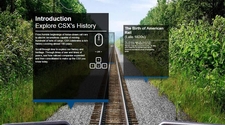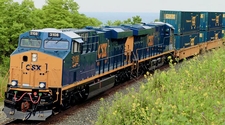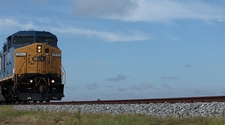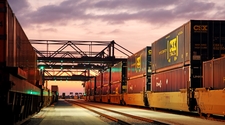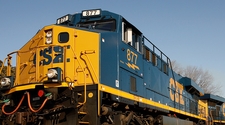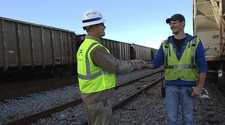| D-Paired |
See Paired Trailer/Container. |
| Damage Free Car (AKA DF Car) |
Car equipped with special bracing devices to decrease the possibility of damage to lading. |
| Dangerous |
Term applied to any shipment of a hazardous commodity |
| Data |
A specific piece or type of information sent to or received from a computer. |
| Data Exchange |
A term applied to the electronic transfer of data from one computer to another. |
| Database |
A collection of information arranged in a computer for speed of retrieval and manipulation. |
| Dead Engine Fixture |
A device on a locomotive for charging main reservoirs from the brake pipe when a locomotive is hauled dead in train. |
| Dead Man Valve (Slang) |
See Pneumatic Foot Valve. |
| Dead Rail |
A second set of tracks over a scale used when cars are not being weighed. |
| Deadhead |
Employee riding on company pass or on company business. OR Train and/or engine crew going from one terminal to another without performing service for which they were paid the regular rate as though they had worked. |
| Deadman |
A buried timber, log or beam designed as an anchorage to which a guy wire or cable is fastened to support a structure, as a wood or steel column, derrick or mast. |
| Deadman Control |
A foot pedal or brake valve which must be kept in a depressed position while the locomotive is operating. A release from this depressed position initiates an air brake application after a short time delay. |
| Debit Amount |
Amount charged to a customer's account as a debt owed CSXT. Normally, payments would be entered as a credit to the customer's account. |
| Declared Value |
The dollar value of the freight shipped as determined by the shipper. |
| Defect Card Receptacle |
A small metal container, placed underneath the car for protection from the weather, in which defect cards are placed. |
| Delay |
Failure to transport a car with reasonable dispatch. OR In train service, the amount of time the train was stopped for various reasons while enroute. |
| Delivering Carrier |
The transportation line delivering a shipment to the consignee. |
| Delivery |
The act of transferring possession of goods such as the transfer of property from consignor to carrier, one carrier to another, or carrier to consignee. |
| Demurrage |
A penalty charge assessed by railroads for the detention of cars by shippers or receivers of freight beyond a specified free time. |
| Department of Transportation (DOT) |
The United States Department of Transportation is a governmental bureau created and empowered by Congress to exercise certain regulatory functions over America's air, water, and land transportation industries. It consists of seven major branches, one of which is the Federal Railroad Administration that deals with matters pertaining to railroads and their operations. |
| Departure Tracks |
An arrangement of tracks to which outgoing freight cars are switched, usually from classification yard or directly from receiving yard, and made ready for train movement. |
| Depressed Center Flat Car (AKA Well Flat) |
A flat car with the section of the floor between the trucks depressed to permit loading of high shipments within overhead clearance limits. |
| Derail (AKA Jack, Jackknife, or Monkey) |
See Derailment. OR A track safety device designed to guide railway rolling stock off the rails at a selected spot as a means of protection against collisions or other accidents. |
| Derailment |
Anytime the wheels of a rail car or engine come off the rails, usually accidentally. |
| Deregulation |
Refers to any traffic not regulated by the Surface Transportation Board. |
| Destination |
The location to which a shipment is consigned. |
| Destination Agent |
Railroad employee at agency delivering freight to consignee. |
| Destination Audit |
Specific identifying number assigned to station at which a shipment is to be terminated. |
| Destination Block |
A group of cars in a train that are all being forwarded to the same destination (city, terminal, yard, railroad connection, or consignee). |
| Destination Road |
The railroad which terminates a shipment at destination. |
| Destination Weight Agreement |
A contract between the railroad and the customer in which the railroad agrees to accept the consignee scale weights. |
| Detention (Car) |
A service for which a charge is assessed against consignors or consignees for detaining or holding intermodal equipment in excess of the free time as specified in commodity tariffs, contracts, etc. for the purpose of loading or unloading at origin or destination or for holding intermodal equipment at designated hold points awaiting further delivery instructions or reconsignment. |
| Detention Charges (TOFC/COFC) |
A charge assessed customers for holding trailers or containers beyond the allowed period for the purpose of loading or unloading. |
| Detention Tariffs |
Tariffs with published rules that govern the amount of free time allowed to customers for pick up and return of trailers/containers and charges to be assessed for violation of these rules. |
| DF Bar |
A metal or wooden bar used to stabilize the load from damage during shipment. |
| DF Car |
Car equipped with special bracing devices to decrease the possibility of damage to lading. |
| Diamond |
See Crossing. |
| Diesel Electric Locomotive |
A locomotive in which the diesel engine drives an electric generator or alternator which in turn supplies electric to motors (usually series, D.C.) which are geared to the driving axles. |
| Diesel Terminal |
Location where locomotives are fueled or repaired. |
| Difference in Money (DIM) |
Balance due after payment which is less or greater than the amount billed has been received from a customer. A rate check may be required to determine if the customer is correct. |
| Differential |
The difference established between rates from related points of origin, or to related points of destination or via different routes between the same points. |
| Differential Routes |
The line or lines which maintain differential rates. |
| Dinky (Slang) |
A small engine used for switching around roundhouses or shops. |
| Direct Traffic Control Block |
A block whose use is governed by verbal authority of the train dispatcher. |
| Direct Traffic Control Block System (DTC) |
A direct traffic control block or a series of consecutive direct traffic control blocks. |
| Directory Rate |
A retail or wholesale public rate for intermodal traffic. |
| Discrimination |
Giving advantage to one shipper, locality or commodity which is not afforded to others under substantially similar circumstances and conditions. |
| Dispatcher (Train) |
Employee responsible for directing and monitoring the movement of trains. |
| Dispatcher Bulletin |
A computer-generated form transmitted by the train dispatcher. It contains the date, location of receipt, train identification number and train messages applying to the train addressed. It contains the engine number when known. It also contains information as to the latest General and System Bulletin issued. |
| Displace (AKA Bump) |
The act of taking one's position and forcing the incumbent employee to another position, based on seniority. |
| Disposition |
Assigning rail cars for loading at specific locations for customers. |
| Disposition File |
Records which document carrier's handling of a freight shipment that has been rejected to the carrier because of damage, shortage and/or delay. |
| Distance Rate (AKA Mileage Rate) |
A rate published to apply for a specified distance or distances falling within specified mileage blocks. |
| Distant Signal |
A fixed signal used to govern the approach to a home signal. |
| Distribution Center |
The centrally located warehouse where goods shipped long distances by rail is loaded onto trucks for short-haul delivery to receivers, or vice versa. Also called a reload center, it combines the economies of rail with the flexibility of truck pickup and delivery. |
| Diversion |
Change in destination or routing before arrival of shipment at original destination. A change made in the instructions covering a shipment in transit - may be a change in destination, route, name of consignee, name of consignor, party to notify, etc. |
| Diversion and Reconsignment |
Terms often used denoting privileges provided by carriers which allow shipping instructions to be changed as to consignee, consignor, destination and routing. In a more specific sense, diversion includes changes in destination or routing before arrival of shipment at original destination, while reconsignment refers to changes in consignee before or after arrival of shipment at original destination. |
| Division |
That portion of a railroad assigned to the supervision of a division superintendent. OR One of six major sections of Conrail consisting of main tracks, yards, stations, and sidings assigned to the supervision of a superintendent. OR The apportionment, by carriers, of revenue received from a shipment moved by more than one rail carrier. |
| Division Notice |
Notice issued by authority and over the signature of the superintendent which contains instructions which do not affect the movement of trains. |
| Docket 28300 |
A mileage scale used to determine base rate. |
| Dog Catcher (Slang) |
A relief crew for a train which has stopped because of the Hours-of-Service law. |
| Dog Law |
See Hog Law |
| Dogs Got 'Em |
Phrase used to indicate that a crew reached the limit of their active hours-of-service time. |
| Domestic Bill of Lading
|
A bill of lading that covers shipments within the United States.
|
| DOT |
See Department of Transportation |
| DOT-E Number |
Department of Transportation Exemption number. Assigned by the DOT for specific commodities which may only be moved with specific approval of the DOT. |
| Double |
Putting a train together when part of train is on one track and balance on another. OR Moving a train or a group of cars from track to track. OR Making a cut in a train too long to fit on a single track, and placing the remaining cars on another track. OR Two consecutive tours of duty. |
| Double Over (AKA Double Up) |
The act of picking up a cut of cars from one location/track and coupling the cars to another cut of cars at a different location/track. |
| Double Stack Train |
A train of specially equipped flat cars on which containers are stacked two-high. |
| Double Track |
Two parallel main tracks. |
| Dozer |
Bulldozer operator. |
| Draft |
A cut of coupled cars. OR Check issued to reimburse a customer for overpayment, duplicate payments, etc. |
| Draft Force |
A term used to describe coupler forces in a state of tension. |
| Draft Gear |
A term used to describe that shock absorbing unit which forms the connection between the coupler and center sill. |
| Drag (Slang) |
A train consisting of miscellaneous loads, empty cars, etc., which is not given a high priority. A train which may be required to pick-up, set out, or switch cars between its origin and destination. OR A train consisting of heavily loaded cars, such as coal, stone, ore, etc. |
| Drawbar |
A heavy metal bar between the coupler and the sliding sill that absorbs shock in coupling. |
| Drawhead |
The head of an automatic coupler, exclusive of the knuckle, knuckle pin and lock. |
| Drayage |
Charge for pickup or delivery of intermodal shipments. |
| Drayman |
A person hired to deliver and/or load and unload trailers for shipper and consignee. Does not own lading in car although sometimes shown as consignee. |
| Drill |
The handling or switching of cars in freight yards. |
| Drill Track |
A track connecting with the ladder track, over which engines and cars move back and forth in switching. |
| Drone |
A locomotive unit without its own controls used in conjunction with one or more other locomotives. See also Radio Controlled Engine. |
| Drop |
Switching movement in which cars are cut off from an engine or other cars and allowed to roll free into a track. |
| Drop Brake Shaft |
A brake shaft for flat cars which normally extends above the floor, but can be dropped down should conditions of lading require. |
| Drop Frames |
A variation of a dry van designed to provide more cubic capacity for light density products such as furniture. |
| Drop-Bottom Car |
A gondola with a level floor, equipped with a number of drop doors for discharging the load. |
| Drop-End Gondola |
A gondola with end doors which can be dropped when the car is used for shipping long material which extends over more than one car. |
| Dry Vans |
Trailer with sidewalls, usually constructed of sheet aluminum, with vertical posts providing rigidity at point of attachment for plywood lining and interior securement devices such as belt rails. Some have sidewalls constructed of fiberglass reinforced plastic. They may be equipped with side doors to facilitate special unloading requirements. Usually 40' to the newer 53' lengths. |
| Dual-Controlled Switch |
A power-operated switch that can also be operated by hand. |
| Dummy Hose Coupling |
A device designed to couple unused air hose for protection against damage and to prevent foreign matter from entering the train line. |
| Dump Car |
A car from which the load is discharged either through doors or by tipping the car body. |
| Dunnage |
The material used to protect or support freight in or on cars, such as bracing, false floors, meat racks, etc. Generally, tariffs or their governing publications will allow a specified amount of dunnage to be transported without charge. |
| Duplex Release Valve |
A manually operated valve on a freight car, which reduces reservoir air pressures, which, in turn, will release the air pressure in the brake cylinder. |
| Duplicate Payment |
An unapplied payment for which the computer was unable to find a corresponding bill number because the bill had cleared by a previous payment. This results in a credit in Accounts Receivable. |
| Duplicate Reporting |
When charges are reported twice on the same shipment. |
| DWORS |
Direct Work Order Reporting System. An On Board Terminal is used to report work performed (cars placed/pulled at customers/line of road) by road and yard crews to the Customer Service Center. |
| Dynamic Brake Modulation |
Minor adjustments of the dynamic braking lever for the purpose of controlling dynamic brake retarding forces. |
| Dynamic Braking |
A method of retarding the locomotive and train by using the locomotive traction motors as generators. The current generated by the motors is dissipated through fan-cooled grids. |
| Dynamic Forces |
The forces created as a result of the movement of the train. The forces may be vertical, lateral, or horizontal. |
| Dynamiter (AKA Kicker, Snapshot, Quick Triple) |
A car on which a defective control valve creates undesired emergency brake applications. |
| back to top |


